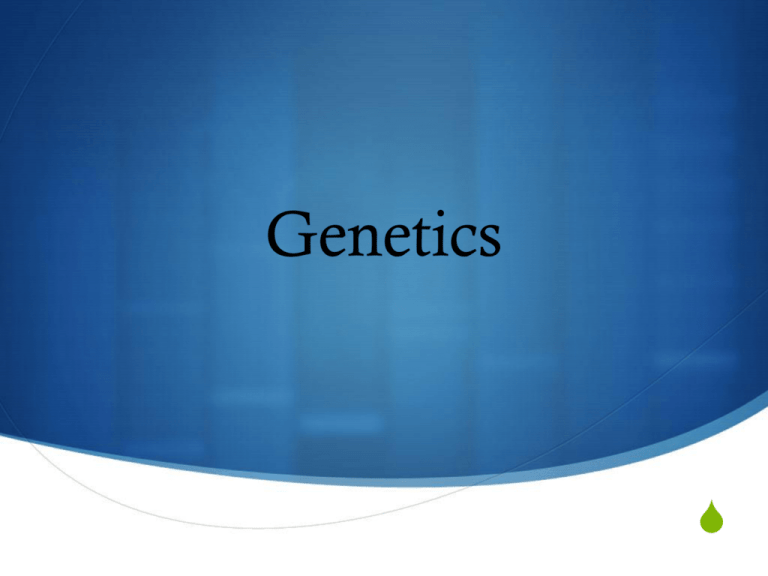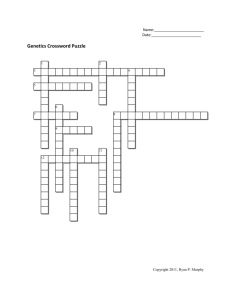
Genetics
S
Vocabulary
S Trait
S Specific characteristic
S Hybrid
S Offspring of parents with different traits
S Gene
S Factors that determine traits
S Allele
S The different forms of a gene
S Segregation
S Separation of alleles
S Probability
S The likelihood an event will happen
S Punnett square
S A diagram to show the results of a genetic cross
S Homozygous
S Have 2 identical alleles
S P = Parental generation
S F1 = First offspring produced
S F2 = Second offspring produced
S Heterozygous
S 2 different alleles
S Phenotype
S Physical characteristics
S Genotype
S Genetic makeup
S Carrier
S Carries a trait but doesn’t exhibit it
S Independent assortment
S Genes do not influence each other’s inheritance
S Incomplete dominance
S When one allele is not completely dominate over another
S Codominance
S Both alleles contribute to the phenotype
S Multiple alleles
S When genes have more than 2 alleles
S Polygenic traits
S Traits controlled by two or more genes
Gregor Mendel
S Known as the “Father of Genetics”
S Genetics = the study of heredity
S Carried out his work with ordinary garden peas.
S Mendel summarized his findings into 2 Laws:
S 1) Law of segregation
S 2) Law of independent assortment
Law of Segregation
S States that every individual possesses a pair of alleles (assuming
diploidy) for any trait
S Each parent passes a randomly selected copy (allele) of only one
of these to its offspring
S The offspring then receives its own pair of alleles for that trait.
S Whichever of the two alleles in the offspring is dominant
determines how the offspring expresses that trait (e.g. the color of
a plant, the color of an animal's fur, the color of a person's eyes).
Law of Segregation
S Proven by meiosis
S The paternal and maternal chromosomes get separated and
the alleles with the traits of a character are segregated into
two different gametes.
Law of Independent
Assortment
S States that separate genes for separate traits are passed
independently of one another from parents to offspring
S Occurs during Metaphase I of Meiosis
S The “double-file” line + crossing over
Punnett Squares
S A capital letter represents the dominant allele
S A lowercase letter represents the recessive allele
S Use the first letter of the dominant trait
S Homozygous Dominant = BB
S Homozygous Recessive = bb
S Heterozygous = Bb
Probability & Segregation
S One fourth (1/4) of the
F2
plants have two alleles
for tallness (TT).
S 2/4 or 1/2 have one
allele
for tall (T), and one for
short (t).
S One fourth (1/4) of the
F2
have two alleles for
short (tt)
Using Punnett Square to Prove
Independent Assortment
S Mendel performed a two-factor cross
SMendel crossed true-breeding plants that produced round yellow
peas (genotype RRYY) with true-breeding plants that produced
wrinkled green peas (genotype rryy).
SAll of the F1 offspring produced round yellow peas (RrYy)
SThe alleles for round (R) and yellow (Y) are dominant over the
alleles for wrinkled (r) and green (y).
The Punnett square predicts a 9 : 3 : 3 :1 ratio in the F2
generation
Incomplete
Dominance
Codominance
Human Heredity
S Karyotype
S A picture of the
arrangement of
chromosomes
S Sex Chromosomes
S X&Y
S Males = XY
Females = XX
S Males determine the sex of the offspring
S Autosomes
S The other 22 pair of chromosomes
S A pedigree chart shows the relationships within a
family.
Human Traits
A circle represents
A horizontal line a female.
A shaded
circle or
square
connecting
a male
and a
indicates
that
a person a
female
represents
expresses
the trait.
marriage.
A square represents
a male. A vertical line and a
bracket connect the
parents to their
children.
A circle or square
that is not shaded
indicates that a
person does not
express the trait.
Copyright Pearson Prentice Hall
S Recessive Alleles
S
The presence of a normal, functioning gene is revealed only when
an abnormal or nonfunctioning allele affects the phenotype.
S
Many disorders are caused by autosomal recessive alleles
S Dominant Alleles
S
The effects of a dominant allele are expressed even when the
recessive allele is present.
S
Two examples of genetic disorders caused by autosomal dominant
alleles are achondroplasia and Huntington disease.
S Codominant Alleles
S
Sickle cell disease is a serious disorder caused by a codominant
allele.
S
Sickle cell is found in about 1 out of 500 African Americans.
S People who are heterozygous for the sickle cell allele are
generally healthy and they are resistant to malaria.
S An individual with both normal and sickle cell alleles has a
different phenotype—resistance to malaria—from someone
with only normal alleles
S If two copies of an autosomal chromosome fail to separate
during meiosis, an individual may be born with three copies
of a chromosome.
S Down syndrome involves three copies of chromosome 21.
S Sex-Linked Genes
S
The X chromosome and the Y chromosomes determine sex.
S
Genes located on these chromosomes are called sex-linked genes.
S
More than 100 sex-linked genetic disorders have now been
mapped to the X chromosome
S For a recessive allele to be expressed in females, there must be
two copies of the allele, one on each of the two X
chromosomes.
S Males have just one X chromosome.
Thus, all X-linked alleles are
expressed in males, even if they are
recessive.






